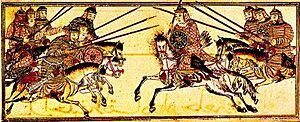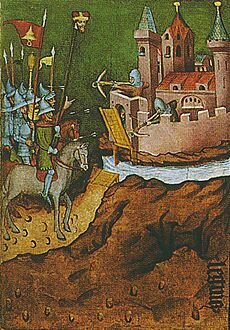Battle of Legnica facts for kids
Quick facts for kids Battle of Legnica |
|||||||
|---|---|---|---|---|---|---|---|
| Part of the Mongol invasion of Poland | |||||||
 Depiction of the Battle of Legnica in 1241 |
|||||||
|
|||||||
| Belligerents | |||||||
| Mongol Empire |
|
||||||
| Commanders and leaders | |||||||
Subutai (strategic coordinator) |
|||||||
| Strength | |||||||
| 3,000–8,000 cavalry | 2,065–8,088 | ||||||
| Casualties and losses | |||||||
| Unknown | Heavy | ||||||
The Battle of Legnica was a major fight between the Mongol Empire and European armies. It happened on April 9, 1241, near the city of Legnica in what is now Poland. This battle was part of the Mongol invasion of Poland.
The European forces were led by Henry II the Pious, who was the Duke of Silesia. His army included soldiers from Poland and Moravia, along with some knights from military groups like the Knights Templar. They tried to stop the powerful Mongol army from advancing further into Europe. The Battle of Legnica took place just two days before another big Mongol victory against the Hungarians at the Battle of Mohi.
Contents
What Was the Battle of Legnica?
The Battle of Legnica, also known as the Battle of Liegnitz or Wahlstatt, was a very important battle in European history. It showed the strength of the Mongol army and their unique fighting style. Most historians agree that the European forces suffered a huge defeat. They lost many soldiers.
Historians sometimes disagree on the exact details of the battle. For example, it's hard to know the exact number of soldiers on each side. Also, some old writings confused one Mongol leader, Kadan, with another, Kaidu. This led to mistakes about who was in charge of the Mongol forces at Legnica.
Why Did the Battle Happen?
The Mongols were expanding their huge empire. They saw the Cumans, a group of people, as part of their empire. But the Cumans ran away and found safety in the Kingdom of Hungary. The Mongol leader, Batu Khan, told the Hungarian King Béla IV of Hungary to hand over the Cumans. When the king refused, the Mongols planned to invade Europe.
Subutai, a skilled Mongol general, planned the invasion. Two main Mongol armies would attack Hungary. A third, smaller army, led by Baidar, Orda Khan, and Kadan, was sent to attack Poland. This attack was a diversion. It was meant to keep northern European armies busy so they couldn't help Hungary.
Orda's forces attacked northern Poland. Baidar and Kadan attacked southern Poland. They first attacked Sandomierz to draw European armies away. Then, they defeated Polish armies in other battles. They captured and burned Kraków. They tried to take Wrocław, but it was difficult. While they were deciding what to do, they heard that King Wenceslaus I of Bohemia was coming with a large army. The Mongols quickly turned to fight Duke Henry's army before it could join with the Bohemian forces. They met Henry's army near Legnica.
Who Fought in the Battle?
The Mongol Army
The Mongol army at Legnica was a smaller part of their main force. It showed how good they were at moving quickly and using horse archers. Their tactics were very clever. They would often pretend to attack, then fake a retreat. This would make the enemy chase them. Then, the Mongols would surround the enemy and attack from the sides. They would also use arrows from a distance to weaken their opponents.
These tactics worked because the Mongols trained constantly. They also had excellent ways to communicate on the battlefield, using flags. Their commanders would find high ground to see the battle and give orders. This was very different from European armies, where knights often charged without much communication.
It's hard to know the exact number of Mongol soldiers. Some old stories say over 100,000, but this is far too high. Modern historians think the Mongol force was probably around 3,000 to 8,000 cavalry (soldiers on horseback). They were very effective even with smaller numbers.
The European Armies
Duke Henry's army was made up of different groups. Historians believe he had around 2,000 to 8,000 soldiers. Many of these were not well-trained or well-equipped. Some were even miners from Goldberg (Złotoryja) who might have used their tools as weapons.
His better-trained soldiers came from his own Silesian lands. There were also some hired soldiers (mercenaries). Small groups of Knights Templar and other volunteers from different countries also joined. The Templars were a military order of knights. They were very well-trained and armed. They reported losing about 68 to 88 of their trained soldiers, plus many other people who worked on their lands.
Some stories say that Teutonic Knights and Knights Hospitaller also fought at Legnica. However, recent studies suggest that these stories might have been added later and are not entirely true. It seems the Templars were the main military order present.
How the Battle Unfolded

Duke Henry divided his army into four parts. The first group was the Bavarian miners. Then came soldiers from Greater Poland and Cracow. The third group was the army from Opole. Finally, Henry led his own Silesian soldiers, Moravians, and the Templars.
The battle started with the Silesian cavalry attacking the Mongol vanguard (the front part of their army). When the Silesians were pushed back, other Polish cavalry groups attacked. The Mongols then pretended to retreat. This made the European cavalry chase them, pulling them away from their foot soldiers.
The Mongols used a clever trick: they created a smokescreen to hide their movements. This confused the Europeans. While the European cavalry was chasing the Mongols, Mongol light cavalry attacked from the sides. Mongol heavy cavalry attacked from the front. Mongol archers shot many arrows at the Polish forces.
One story says that during the Mongol's fake retreat, someone shouted "Run! Run!" in Polish. This confused Duke Mieszko II the Fat, who ordered his Opole soldiers to retreat. This made Henry send his own reserves into the fight.
The Mongols' feigned retreat was very successful. It separated the European knights from their infantry. This allowed the Mongols to defeat the European forces one by one. Henry's army was almost completely destroyed. Henry himself and Boleslav of Moravia were killed. It is believed that almost the entire European army was lost. Mongol losses are not known, but they were probably much smaller.
What Happened After?
King Wenceslaus I of Bohemia was only a day's march away when he heard about the defeat. He decided to fall back and gather more soldiers from other regions. The Mongol vanguard caught up with him, but Wenceslaus's army was much larger. The Mongol group was defeated by the Bohemian cavalry.
Since the Mongol army at Legnica was meant to be a diversion, they didn't try to fight the larger Bohemian army. Instead, they split into smaller groups. They attacked and looted smaller towns and villages. Eventually, they left Bohemia and Poland. They headed south to join the main Mongol armies. These armies had already defeated the Hungarians at the Battle of Mohi.
Later, the Mongols launched more invasions of Poland, mainly to loot. They successfully raided Poland again in 1259–1260. They tried again in 1287 but were not successful. Even though the Mongols wanted to conquer central Europe, Poland and Hungary remained free from their direct rule. However, the Russian lands to their east stayed under Mongol rule for about 200 years.
The Battle of Legnica is remembered today. It is honored on the Tomb of the Unknown Soldier, Warsaw, with the words "LEGNICA 9 IV 1241".
See Also



